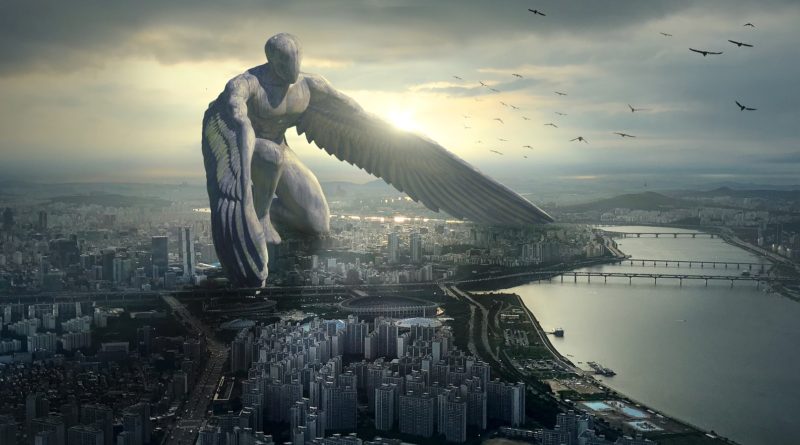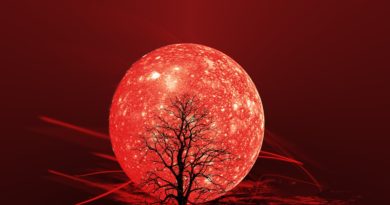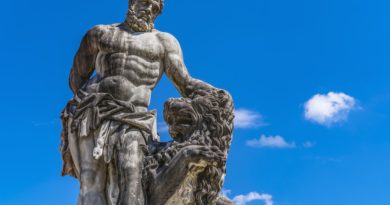‘Mystery, Babylon’ and the Church
Has the Apostate Church ‘gained the whole world, but lost her soul’?
By S. Douglas Woodward
Rome declined in the sixth century A.D. and was followed by its near total desolation. Famous commentator on the scripture, Albert Barnes suggests this notion was the hidden meaning of the reference to the “wilderness” or “desert”in Revelation 17:3.
He cites Edward Gibbon’s, The History of the Decline and Fall of the Roman Empire (originally published in 1776, a most auspicious date), which references the conditions surrounding Rome before the time of Gregory the Great (c. 540 – 604 A.D.), when Rome’s resurgence began under its Papal administration:
“Rome had reached, about the close of the sixth century, the lowest period of her depression. By the removal of the seat of empire, and the successive loss of the provinces, the sources of public and private opulence were exhausted; the lofty tree under whose shade the nations of the earth had reposed was deprived of its leaves and branches, and the sapless trunk was left to wither on the ground… Such incessant alarms must annihilate the pleasures, and interrupt the labors of a rural life; and the Campagna of Rome was speedily reduced to the stale of a dreary wilderness, in which the land is barren, the waters are impure, and the air is infectious. Curiosity and ambition no longer attracted the nations to the capital of the world; but if chance or necessity directed the steps of a wandering stranger, he contemplated with horror the vacancy and solitude of the city; and might be tempted to ask, ‘Where is the Senate, and where are the people?’”
The Woman Rides the Beast

Emphasizing the spiritual condition of the future church more than the Roman countryside, Adam Clarke (1831) provided his assessment of the meaning of wilderness – “So, he carried me away in the spirit into the wilderness(Rev. 17:3).”
“This wilderness into which the apostle was carried is the desolate state of the true Church of Christ, in one of the wings of the once mighty Roman empire. It was a truly awful sight, a terrible desert, a waste howling wilderness.”
Joseph Benson, a Methodist minister wrote his commentary on Revelation in 1847, interprets the 1,260 days as years (the “Day/Year Theory”), like other commentators he sees in the desert a reference to the spiritual condition of the church. In so doing, he points out the contrast between the true church (as he interprets “the woman” of Revelation 12), with the apostate church in Revelation 17. He comments:
“Revelation 17:3. So he carried me away— Namely, in the vision. As Ezekiel, while he was a captive in Chaldea, was conveyed by the Spirit to Jerusalem (Ezekiel 8:3,) so John is carried away in the Spirit into the wilderness; for there the scene is laid, being a scene of desolation. When the woman, the true church, was persecuted and afflicted, she was said (Revelation 12:14) to flee into the wilderness: and, in like manner, when the woman, the false church, is to be destroyed, the vision is presented in the wilderness. For they are by no means, as some have imagined, the same woman, under various representations. They are totally distinct and different characters, and drawn in contrast to each other, as appears from their whole attire and behaviour, and particularly from these two circumstances, — that during the one thousand two hundred and sixty years, while the woman is fed in the wilderness, the beast and the scarlet whore are reigning and triumphant, and, at the latter end, the w***e is burned with fire, when the woman [of Revelation 12], as his wife, hath made herself ready for the marriage of the Lamb.”
J.N. Darby, the father of Dispensationalism, had a similar view concerning the meaning of the woman. Said Darby, “She was in the desert; no springs of God were there. It was not, so to speak, God’s land, no heavenly country.” William Kelly, another nineteenth-century theologian who began as a follower of Darby, connects the wilderness of Revelation 17, with the poor condition of the Church while also acknowledging the desolate conditions surrounding Rome. Along the way of his exposition, he connects this “wilderness”as “the desert of the sea,” quoting the words of Isaiah, chapter 21:

“’And he carried me away in Spirit into a wilderness.’ It is a thorough waste as to the knowledge or enjoyment of God. So, in Isaiah 21 the prophet opens the chapter with that which was far beyond the horizon of the keenest creature view: ‘the burden of the wilderness of the sea,’ so different from the burden which he saw and gave in Rev. 13, 14, as ‘the golden city.’ Hence some refer a ‘wilderness’ here to the Campagna of Rome and its desolation under the Popes as contrasted with its prosperous and populous splendour under the Caesars. This is no doubt true and significant, though spiritual drought and dreariness seem more consonant to the Spirit’s expression.”
It is not common to think of the sea as a desert for it teems with life throughout its waters. But for human beings, the water is undrinkable. From the standpoint of supporting human life, the ocean is a wilderness – it is a vast desert with no water to slate our thirst. Additionally, its tumultuous tossing to and fro promises catastrophe for any human who lacks being anchored to a stable platform.
The Campagna Surrounding Rome

John Wesley, almost a hundred years earlier, had argued the same essential point: “The campagna di Roma, the country round about Rome, is now a wilderness, compared to what it was once.”
For these writers, the wilderness or desert referred primarily to apostasy of the Church, its spiritual state. However, they saw in the Campagna, a physical reinforcement of the image. To expand this point of view further, consider this next comment. The Expositor’s Bible provides a lengthy analysis challenging the generally accepted “default view” that the wilderness (along with the mysterious woman) refers to Rome geographically and the Papacy specifically.
Various opinions have been entertained as to the meaning of Babylon, of which the most famous are that the word is a name for papal Rome, pagan Rome, or a great world-city of the future which shall stand to the whole earth in a relation similar to that occupied by Rome toward the world of its day.
These opinions cannot be discussed here [for want of space]; and no more can be attempted than to show, with as much brevity as possible, that by Babylon is to be understood the degenerate Church, or that principle of degenerate religion which allies itself with the world, and more than all else brings dishonor upon the name and the cause of Christ. (Revelation 17, Expositors Bible, emphasis added)
The criticism is not so much that the woman’s idolatry is connected to a set of beliefs about the nature of God or His manner of granting reconciliation; but rather, to the woman’s escort and her haughtiness at being paired with the power source of the secular world. Now, she believes her destiny is higher ground as she rides up high on the back of the beast. Instead, her destiny rests in the pit as she makes her bed with the beast and is destined to be bucked off into the ditch.
The Wilderness and ‘Mystery, Babylon’

Easton’s Bible Dictionary explores, in depth, the use of the term “wilderness” or “desert.” For the convenience of the reader, I identify each of the uses (mostly Old Testament) from Easton’s in a style consistent with my article’s formatting. As shown below, the words are a direct quotation with only a few simplifications and paraphrases. “Wilderness” (a noun) is synonymous with “desert.”
These words comprise the typical manner in which the King James Version translates five distinct Hebrew words and names. All instances convey desolation or arid land with the exception noted first in the following list:
- Midhbar, denoting not a barren desert but a district or region suitable for pasturing sheep and cattle (Psalms 65:12; Isaiah 42:11; Jeremiah 23:10; Joel 1:19; 2:22); an uncultivatedplace.This pleasant usage comes through inference (depending upon the word’s context).
However, it is generally considered an unpleasant place as evidenced in the following passages:
- This word is used of the wilderness of Beersheba (Genesis 21:14), on the southern border of Palestine; the wilderness of the Red Sea (Exodus 13:18); of Shur (15:22), a portion of the Sinaitic peninsula; of Sin (17:1), Sinai (Leviticus 7:38, Moab (Deuteronomy 2:8), Judah (Judges 1:16), Ziph, Maon, Engedi (1 Samuel 23:14; 1 Samuel 23:24; 24:1), Jeruel and Tekoa (2 Chronicles 20:16; 2 Chronicles 20:20), Kadesh(Psalms 29:8).
- “The wilderness of the sea” (Isaiah 21:1). “A prophecy against the Desert by the Sea: Like whirlwinds sweeping through the southland, an invader comes from the desert, from a land of terror.”
Principal Douglas, referring to this expression, calls it a mysterious name, which must be meant to describe Babylon (see especially verse 9), perhaps because it became the place of discipline to God’s people, as the wilderness of the Red Sea had been (compare Ezek. 20:35). Otherwise it is in contrast with the symbolic title in Isaiah 22:1. Jerusalem is the “valley of vision,” rich in spiritual husbandry; whereas Babylon, the rival centre of influence, is spiritually barren and as restless as the sea (compare Isaiah 57:20).
- Jeshimon, a desert waste (Deuteronomy 32:10; Psalms 68:7). The Dead Sea “Arabah,” the name given to the valley from the Dead Sea to the eastern branch of the Red Sea. In Deuteronomy 1:1; 2:8, it is rendered “plain” (RSV, “Arabah”).
- Tziyyah, a “dry place” (Psalms 78:17; 105:41).
- Tohu, a “desolate” place, a place “waste” or “unoccupied” (Deuteronomy 32:10; Job 12:24; Compare Genesis 1:2, “without form”). The wilderness region in the Sinaitic peninsula through which for forty years the Hebrews wandered is generally styled “the wilderness of the wanderings.” This entire region is in the form of a triangle, having its base toward the north and its apex toward the south. Its extent from north to south is about 250 miles, and at its widest point it is about 150 miles broad. Throughout this vast region of some 1,500 square miles there is not a single river. The northern part of this triangular peninsula is properly the “wilderness of the wanderings” (et-Tih). The western portion of it is called the “wilderness of Shur” (Exodus 15:22), and the eastern the “wilderness of Paran.”
In the New Testament, its author (writing in Greek) cast the “wilderness of Judea” (Matthew 3:1) as a wild, barren region, lying between the Dead Sea and the Hebron Mountains. It is the equivalent of “Jeshimon” mentioned in 1 Samuel 23:19.
When Christ faced Satan in the wilderness, He battled with him alone. For him, the wilderness meant isolation – desolate, unoccupied, without God. Mystery Babylon does not recognize its situation represents the very same, for it resides without God, dealing directly with Satan but with a false confidence that it sits comfortably at the controls. The woman has made her choice. Unlike Christ, she accepted the devil’s bargain. The woman chose the world. With her decision made, she “gained the whole world, but lost her soul.” (Matthew 16:26)
The Dust of Death

The Spirit carries John away, into the wilderness, which signifies sparseness of life. The language of wilderness means a place with nothing green and growing. Think of the word verdant – an expression meaning lush greenery.
The wilderness is its exact opposite. It is not a forest, it is nothing but rocks, sand, lizards, and scorpions. This symbol of desert assures us that Babylon enjoys no spiritual life whatsoever.
For those who believe in the Bible, Mystery Babylon plainly represents death – separation from the God of life. Its air chokes all those that are unfortunate enough to reside there. In the desert, the sunlight is heavily filtered through clouds of dust, with dull, tannish rays rarely even producing shadows on the gritty, dismal terrain.
When we speak of its barrenness however, we are speaking of its spiritual condition. As stated in the earlier articles posted here, Revelation expresses the nature of “Mystery, Babylon” to us with numerous symbols pointing to six legitimate locations, all arguably supported by biblical exposition.
But the true location of Babylon must take all of these factors into consideration, for “Mystery, Babylon” comprises more than one place at more than one point in history. It is not just a physical location.
Every Bible prophecy pundit wishes to point to one place, to lay claim to one institution, isolating only one leader that constitutes the transcendent enemy of the elect. But “Mystery, Babylon” dismisses all such attempts to corner its meaning so simply. It possesses many illegitimate daughters that mimic their mother, making only one and only one such woman impossible to pinpoint. Instead, we must identify its ethos and warn others of its presence.

For it is more than a church whose clergy wear scarlet while its mandated mediation between believers and their God pushes them further apart. It includes any and all churches where the most essential spirit of those churches separates believers from their true Creator.
By stating this, it should not be understood to mean that we cannot locate where Babylon resides today. We can and we should. It may be a specific city. It may be characterized by tyrannical political power, vacuous spiritual beliefs, or economic criminality on a massive scale. But it is to say we must first recognize what rests in the background before we can come to see with clarity what lies in the foreground.
The Mega-Church of Prosperity

“Mystery, Babylon” will always occupy a preeminent position for those who seek to gain power and benefit through association with its gilded appearance.
Each generation must work through the symbols of Revelation and decide where Babylon dwells while that generation inhabits the world – and do its best to avoid the domicile of the desert both physically and spiritually.
The Church as the “woman that rides the beast” believes it sits in the driver’s seat. But the beast remains always in control. The woman is nothing more than a “hood ornament” for those who view the traveling companions from a distance.
Soon, the woman will find she has been rejected once her value has waned. The woman will be dumped along the roadside and left for dead. For we know the beast hates the woman… and soon, will set her ablaze. Indeed, the fiery fate of the woman seems assured. Scripture tells us so.
“And the ten horns which thou sawest upon the beast, these shall hate the w***e, and shall make her desolate and naked, and shall eat her flesh, and burn her with fire.” (Revelation 17:16)
This article originally appeared on Faith Happens. Read it here: http://faith-happens.com/the-many-ciphers-locating-future-babylon-pt-2/

S. Douglas Woodward, Th.M., MA in Finance (to be completed, May 2019), is 64. He grew up in Oklahoma City, where he lives once again, after working in Boston for six years and Seattle for 21. Doug’s experience lies primarily in business information technology and financial management where he has served as an executive for Oracle, Microsoft, and a Partner at Ernst & Young LLP. He also founded his own consultancy for young companies, Smart Starters, which he managed for 10 years, before becoming Entrepreneur-in-Residence at the University of Oklahoma, Price School of Business, where he has taught classes in entrepreneurship for five years. Over the past seven years, Doug has become a nationally recognized author having written fourteen books on the topics of America’s spiritual history, eschatology, theology, and geopolitics. His books of note include The Final Babylon, Decoding Doomsday, Power Quest (Books One and Two), Lying Wonders of the Red Planet, The Revealing, The Next Great War in the Middle East, and Revising Reality. Rebooting the Bible is number fifteen. He frequently appears on radio and television programs having been interviewed on over 100 different occasions on several dozen different shows. Additionally, he speaks at conferences concerning the multiplicity of topics about which he writes. Doug has two amazing adult children, an incredible daughter-in-law, two fabulous grandsons, and a beautiful wife, Donna, with whom he celebrates over 43 years of marriage. Discover more at www.Facebook.com/sdouglaswoodward and www.faith-happens.com.–




